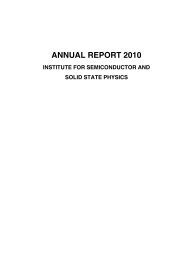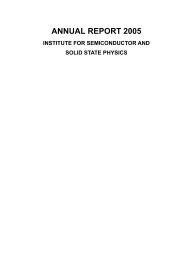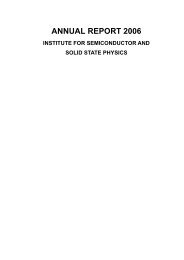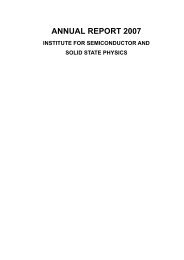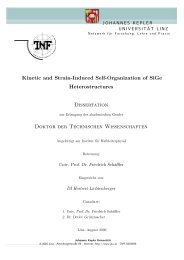Annual Report 2008 - Institut für Halbleiter - JKU
Annual Report 2008 - Institut für Halbleiter - JKU
Annual Report 2008 - Institut für Halbleiter - JKU
You also want an ePaper? Increase the reach of your titles
YUMPU automatically turns print PDFs into web optimized ePapers that Google loves.
12 Research Initiatives Part A: Semiconductor Physics Group<br />
Project Cluster Nanostructured Surfaces and Interfaces (NSI)<br />
F. Schäffler<br />
The project clusters NSI: Nanostructured Surfaces and Interface, is funded by the Austrian<br />
NanoInitiative since 2005. Work is carried out by a consortium around the Johannes Kepler<br />
University and Upper Austrian Research (UAR). So far, funding was granted for two-year<br />
periods, after which a fully refereed new proposal was required. After two funding periods<br />
(03/2005 - 02/2007 and 03/2007 - 02/2009) in <strong>2008</strong> the proposal and hearing for the third<br />
funding period was due. Modifications in the funding rules led to an increase of the duration<br />
of funding periods to three years, while simultaneously limiting the overall duration of a project<br />
cluster to seven years. On this base the NSI consortium submitted a proposal for its last<br />
funding period 03/2009 - 02/2012. Several modifications in the project structure were introduced<br />
in order to put more emphasis on applied research and nanoanalytics. New partners<br />
were recruited, and new projects were introduced, while others were phased out, as planned.<br />
As an outcome of the hearing and the decision of the Austrian Nanoinitiative, funding for NSI<br />
was granted in Dec. <strong>2008</strong> for the final three year period. Total funding for this period will<br />
amount to € 3.1M, at a total project volume of € 3.6M.<br />
The third funding period of NSI will bring together five (up from four) research institutions<br />
and six (up from five) companies. The former comprises Johannes Kepler University, UAR,<br />
the University and the Technical University of Graz and the Technical University in Vienna.The<br />
companies are from Upper Austria, Lower Austria and Vienna. NSI is coordinated<br />
by the <strong>Institut</strong>e for Semiconductor and Solid State Physics (coordinator: F. Schäffler).<br />
The general purpose of NSI is, to link the expertise and infrastructure in the field of<br />
NanoScience and Technology, which was systematically developed since the early 1990s in<br />
Linz and Upper Austria, and to make them available to both the Austrian industry and to education<br />
inside and outside the university. In this way, NSI is directly related to the aims of the<br />
Exzellenzschwerpunkt in NanoScience/Technology, which was established in 2003 at Johannes<br />
Kepler University. NSI covers the main competence areas at Johannes Kepler University,<br />
namely Biocompatible Nano-structures, Polymers and Nanocomposites, Surfaces and Interfaces<br />
and Semiconductor Nanostructures. The latter contributes chemical synthesis of semiconducting<br />
nanocrystals, nanostructuring in the cleanroom of the <strong>Institut</strong>e for Semiconductor<br />
and Solid State Physics, and nanoanalytics. Additional contributions of the institute to the<br />
aims of the Austrian Nanoinitiative are made via participation in two other project clusters,<br />
namely PLATON and NILAustria.<br />
Besides overall coordination, the <strong>Institut</strong>e for Semiconductor and Solid State Physics is directly<br />
involved in four of the nine (eight) projects of the second (third) funding period of NSI.<br />
More Information: www.nanoscience.at<br />
Funding: Austrian Nano Initiative (FFG, FWF)<br />
Corresponding Author: Friedrich.Schaffler@jku.at




